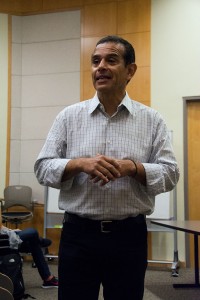Former Los Angeles mayor speaks to Price students
Former Mayor of Los Angeles Antonio Villaraigosa met with students from the Sol Price School of Public Policy and the Environmental Student Assembly on Monday to discuss the city’s environmental policy efforts as part of the course PPD 225: Public Policy and Management, taught by Professor Nicole Esparza.

Keepin’ it green · Former Los Angeles mayor Antonio Villaraigosa speaks to students as part of Professor Nicole Esparza’s PPD 225 course. – Mariya Dondonyan | Daily Trojan
Prior to being elected, Villaraigosa served as Speaker of the California State Assembly and as a member of the Los Angeles City Council. Last year, Villaraigosa was named a professor of the practice of policy at the Price School, a title reserved for faculty appointments of individuals who have made significant contributions in the public practice of their field of expertise.
During his visit, Villaraigosa discussed his efforts as mayor to improve Los Angeles’ environmental sustainability and the challenges the city continues to face in implementing new strategies.
Villaraigosa’s interest in environmental protection was sparked by his childhood observations of the city’s poor air quality.
“Back when I was growing up, you actually couldn’t leave the classroom because of the bad air quality … you couldn’t see the mountains most of the time,” he said.
In the early 1990s, when Villaraigosa was first elected to the California State Assembly, there were debates about air quality regulations and whether they were too strict for businesses.
“Legislators like myself challenged the notion that we shouldn’t do something dramatic to fix the environment,” Villaraigosa said.
Despite facing backlash from private industry, Villaraigosa and others held their ground in the state assembly to change the city’s environmental status quo and address the concerns of constituents.
Once elected mayor, Villaraigosa said he took a hands-on role in rewriting the city’s environmental policy. He spoke about his efforts regarding four main issues: the city’s air quality, availability of public transportation, reliance on coal and port pollution. Upon Villaraigosa’s election, Los Angeles was 42 percent dependent on coal, but by retrofitting existing power plants for natural gas and transforming the Port of Los Angeles to solely electric power, environmental regulations put in place by Villaraigosa’s administration will eliminate the city’s coal dependency by 2025.
Villaraigosa said the drought was a focus of his while he was in office. To respond to California’s worsening drought conditions, the city restricted households to watering lawns twice a week and only at specific times of day. In addition, Villaraigosa said he created a program to help households replace grassy lawns with desert landscaping that better conserves water. Today, Los Angeles uses less water per capita than any other city in the United States with more than 1 million people.
“Through discussion of his experience as mayor and creating new environmental policy, Villaraigosa tied the legislative processes with the same implementation challenges that we are learning in class,” said Brandon Delijani, a junior majoring in policy, planning and development.
To address the issue of limited public transportation, Villaraigosa invested in expanding the city’s Metro lines. According to city plans, the Expo Line will reach Santa Monica by 2015. Under Villaraigosa, Los Angeles also established the only public bus system operated completely on natural gas in the United States. Students had the opportunity to engage in a dialogue with Villaraigosa and apply his insights to concepts introduced in the course.
“As a student new to the Price School, it was interesting to hear from an experienced policymaker like Villaraigosa,” said Xander Mason, a freshman majoring in policy, planning and development. “It was definitely a unique experience to hear him talk about the policies he introduced as the mayor of Los Angeles and think about how they have affected our lives for the better.”
Though Villaraigosa said his environmental policy agenda was initially perceived as too ambitious by other elected officials, he said he invested in improving the city’s sustainability anyway because he knew it was sound policymaking.
“Don’t accept the idea that public life is just about hitting singles and doubles. You can’t be afraid to swing for home runs,” Villaraigosa said. “If you want to make investments for the good of the public, you can’t let a few individuals block progress.”
Shawn Rhoads, executive director of the Environmental Student Assembly, said he was glad to hear Villaraigosa speak.
“Mayor Villaraigosa’s lecture was very energizing,” he said. “USC is an intellectual center for Los Angeles, so it is important that our campus moves forward with sustainability initiatives to keep pace with the city. We are glad that the Environmental Student Assembly could partner with the Price School to bring Villaraigosa to campus and create a dialogue among students.”

